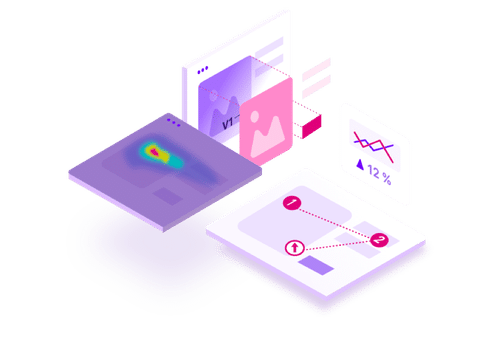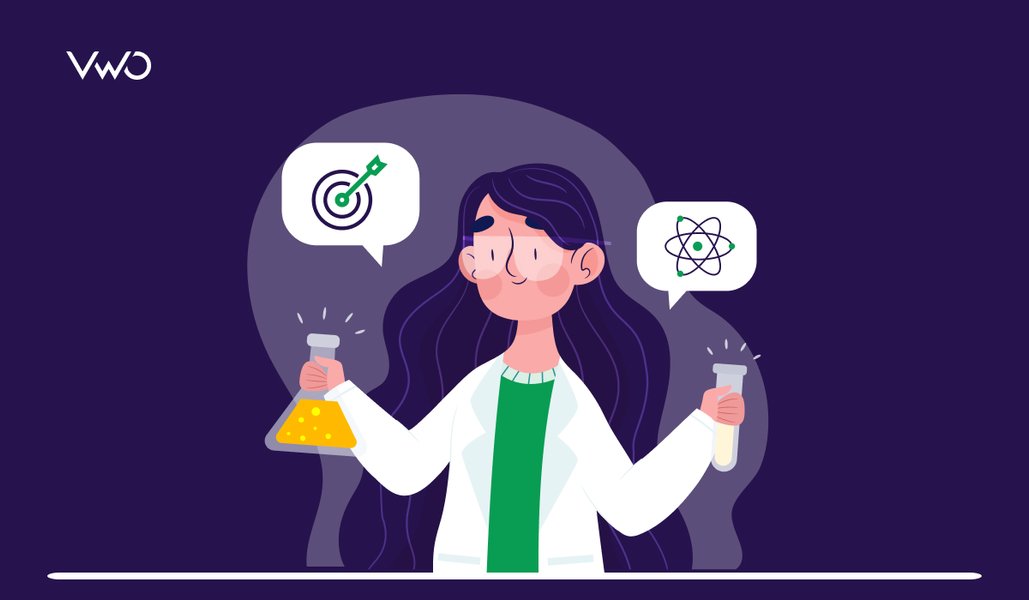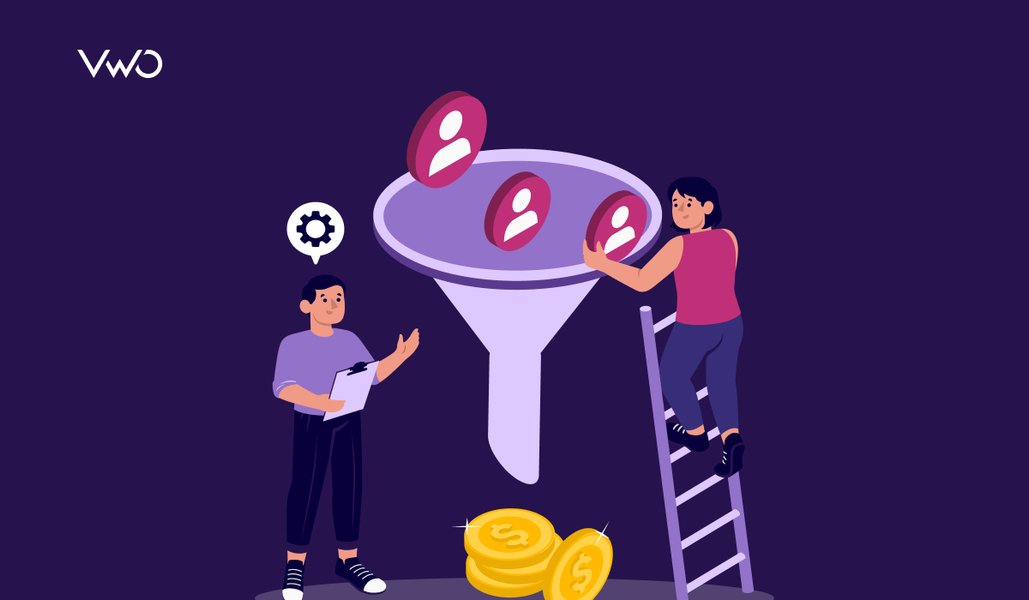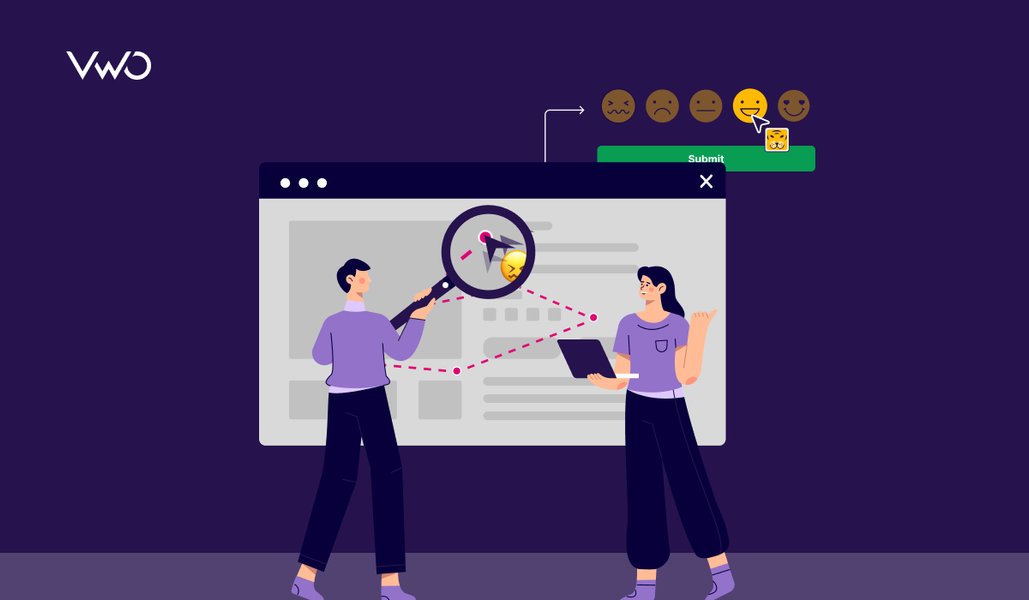7 Best Customer Segmentation Software in 2026: The Ultimate Guide
More customer data is at your fingertips than ever: clicks, scrolls, time on page, and purchase history. However, more data does not mean more clarity. That’s where customer segmentation steps in.
Segmentation isn’t just about showing the right message to the right person. It’s about slicing through layers of customer data to uncover patterns, identify high-value segments, and trigger action based on real behavior.
Whether it’s grouping users by lifecycle stage, filtering by campaign source, or spotting drop-off points in a journey, segmentation empowers teams to move from assumptions to evidence.
In fact, businesses that use segmentation effectively can see up to a 50% increase in conversion rates, according to recent statistics.
In 2026, smart segmentation is no longer optional; it’s the engine behind smarter targeting, leaner campaigns, and stronger results. In this guide, we break down 7 of the best customer segmentation tools to help you uncover what drives impact.

What is a customer segmentation tool?
A customer segmentation tool is a software solution that helps businesses group users based on shared characteristics, such as behavior, demographics, acquisition source, or customer value, to better organize and analyze customer data.
By slicing large datasets into meaningful segments using filters and conditional logic, teams can uncover hidden patterns and insights that would otherwise be lost in the noise. This deeper understanding enables more precise personalization—tailoring messages, experiences, and offers to what specific groups care about. Ultimately, segmentation drives smarter targeting, more effective experimentation, and strategic decision-making throughout the customer journey.
7 Best customer segmentation software: Quick glimpse
Disclaimer: The pros and cons are based on reviews and feedback from third-party sites such as G2, TrustRadius, and other sources.
7 best customer segmentation software – A detailed view
1. VWO – Segment-based experimentation and behavioral insights

VWO, as an experience optimization platform, offers built-in segmentation in VWO Testing to help you see how different types of users respond to each variation in your A/B tests.
It supports pre-segmentation and post-segmentation, so you can control who enters the test and how results are interpreted.
- Pre-segmentation allows you to define audience segments before running experiments, targeting users based on criteria such as device type, location, referral source, time of visit, and user behavior. This ensures that tests are exposed only to relevant visitor groups.
- Post-segmentation enables you to analyze experiment results by filtering data according to specific visitor segments. This helps in understanding how different user groups respond to variations, facilitating data-driven decision-making.
Through its segmentation interface, VWO offers:
- Standard segments: Predefined segments such as Direct Traffic, Social Traffic, and Referral Traffic.
- My segments: Custom segments created using standard and custom attributes, which can be saved and reused across campaigns.
- Custom segments: Segments based on specific conditions like browser type or device used, allowing for granular targeting.
Use VWO Copilot to quickly generate audience segments and triggers using simple text inputs. This simplifies complex logic and saves time without the need for manual setup or technical effort.
Apart from testing, segmentation is available within VWO Insights, the behavioral analytics capability of VWO, to help you analyze how specific visitor groups interact with your website.
You can create and save customized views to track user activity for defined segments, based on geolocation, device type, referral source, browsing behavior, and more. Using segmentation in VWO Insights, you can:
- Generate heatmaps for specific segments.
- Filter heatmaps by test campaigns.
- Use Session Recordings to view segment-specific journeys.
- Filter funnel reports by date and segment (when segmentation is enabled for the goal)
This allows you to focus on the user behaviors that matter most and uncover targeted insights that drive better decisions.
Additionally, for those exploring segmentation specifically for personalization, VWO’s CDP, Data360, helps build unified customer profiles by pulling data from websites, mobile apps, and third-party sources. Marketers can then create rule-based segments using a mix of on-site behavior and external attributes, and trigger personalized experiences in real time via VWO Personalize.
Take the free trial today to explore its segmentation and optimization capabilities.
Additional features
Advanced Targeting, Device/Location/Source-Based Targeting, Saved Segments, Visual Editor, Code Editor, Behavioral Triggers, Behavior Analytics, A/B Testing, Program Management
Free trial
- 30-day full-feature trial available.
Pricing
- Free: Available for up to 10k MTUs.
- Paid: Various plans start from $199/month, billed annually.
Pros:
- Segmentation and targeting are easy to set up, enabling personalized, audience-specific experiments that deliver relevant and actionable insights.
- Helps improve conversion rates across funnels through precise targeting and iterative experimentation.
Cons:
- VWO’s segmentation does not extend to channels like email, SMS, or mobile push.
2. Klaviyo – Behavioral segmentation for cross-channel marketing

Klaviyo is a marketing automation platform that enables advanced behavioral segmentation and real-time personalization. It gathers purchase history, website activity, and email engagement data to build dynamic customer segments that continuously update as customer behavior changes.
Marketers can describe their ideal audience with Segments AI and instantly generate predictive segments to use across campaigns. Klaviyo’s cross-channel capabilities ensure personalized experiences stay consistent across email, SMS, and other customer touchpoints while also making performance measurement easier.
Additional features
Hyper-precise AI Segmentation, Predictive Audience Generation, Segment Cloning, Cross-Channel Campaign Management, Customer Data Collection, Behavioral Targeting, Personalized Messaging, AI Tools
Free trial
- Free tier available for up to 250 contacts and 500 email sends.
Pricing
- Paid plans start from approximately $20/month based on active profiles and feature usage.
Pros:
- It integrates well with tools like Shopify, Chargebee, and Amplitude, pulling in all the data needed to reach targeted audiences for personalized, high-performing campaigns.
- The detailed, real-time analytics give clear insights into open rates, click-throughs, and revenue impact.
Cons:
- Limited tracking capabilities for push notification campaigns can make performance measurement challenging.
- Segmentation may be difficult to navigate for users unfamiliar with digital marketing workflows.
3. Segment – Unified data for smarter segmentation and audience targeting

Segment by Twilio brings together customer data from websites, apps, and other sources to build a single, consistent profile for each user. It allows marketers to build precise, behavior-based segments, like cart abandoners, frequent visitors, or users with high engagement.
With AI-driven predictive modeling, Segment helps identify audiences such as “ready to buy” or “at-risk,” and lets teams create segments quickly using simple text prompts.
Marketers can also create and update these segments using simple text prompts, making audience-building faster and more intuitive. This ensures that messaging is always consistent, relevant, and powered by real-time insights.
Additional features
Real-Time Data Activation, Unified Customer Profiles, Predictive Segmentation, Audience Syncing, AI Recommendations, Event Tracking, Journey Orchestration, Trigger Campaigns, AI Predictions, Text-Prompt Audience Builder, Generative AI, Activate Audiences
Free trial
- 14 days are available for only the Connections plan.
Pricing
- Connections plan:
- Free: Up to 1000 visitors/month.
- Paid: Starts from $120/month.
- CDP plans:
- Pricing is not available on the website. Custom pricing and a Demo can be requested.
Pros:
- Integrates quickly with minimal engineering effort, making setup fast and accessible.
- Provides flexibility to work with multiple data sources, traits, and audience types, ideal for building a scalable user data strategy.
Cons:
- Reporting and testing options are somewhat limited, and audience creation or export may occasionally require extra effort.
- The pricing might be less suitable for smaller teams or early-stage businesses with tighter budgets.
4. Mailchimp – Segmentation for email marketing

Mailchimp powers smarter, more personalized email marketing by helping businesses create high-impact segments built on customer engagement, behavioral data, and predictive insights. With behavioral and interest-based segmentation, brands can target contacts based on real actions like purchases, preferences, and email activity, which ultimately enhances customer retention.
Its predictive segmentation further sharpens the focus by identifying customers most likely to buy again, allowing marketers to prioritize high-value audiences and tailor their messaging for maximum impact.
This targeted approach drives higher engagement, boosts conversions, and strengthens long-term customer loyalty.
Additional features
Survey-Based Targeting, Pre-Built Segments, Audience Segments, Tags, Customer Journeys, Personalized Onboarding, Behavioral Targeting
Free trial
- 14 days limited to 500 contacts.
Pricing
- Paid plans start from $13/month.
- Plans offering advanced segmentation features start from $20/month.
Pros:
- The automation features save time and help boost productivity.
- The comprehensive analytics help understand the audience better and tailor content to their preferences.
Cons:
- The basic tier limits the number of contacts to 500, which may feel restrictive for growing businesses.
- Once an email is sent, it cannot be edited or recalled.
5. Userpilot – Granular segmentation for in-app personalization

Userpilot enables product teams to segment users by job role, plan type, sign-up date, location, or any other user attribute, allowing for tailored experiences throughout the product journey. This granular segmentation supports personalized onboarding, contextual in-app messages, and targeted surveys that are triggered based on specific user segments.
With the ability to deliver relevant content and surveys to the right users at the right time, Userpilot helps personalize every interaction at scale. Segmentation seamlessly integrates onboarding flows, feedback collection, and product experiences to drive better engagement and retention.
Additional features
In-App Experiences, Trend Analytics, Retention Cohort Analysis, Onboarding Flows, Granular Targeting, Survey Personalization, Product Usage Insights
Free trial
- 14 days are available to experience the platform.
Pricing
- Paid plans start from $249/month, billed annually.
Pros:
- Easy integration of connected data enables better targeting and flow triggering.
- The no-code builder simplifies the creation of in-app messages while segmentation ensures they reach the right users at the right time.
Cons:
- The analytics dashboard could be improved with greater clarity and advanced features for deeper user behavior analysis.
- Userpilot can have a steep learning curve for non-technical users.
6. Insider – Deep segmentation for personalized customer journeys

Insider allows marketers to segment audiences using over 120 attributes, including behaviors, preferences, purchase history, and CRM data. With granular targeting options like predictive segments and RFM models, brands can deliver highly personalized experiences that boost engagement and ROI.
Its flexible rule engine supports parameters based on sessions, exit intent, or even weather, while also allowing custom rule creation for greater control. Real-time segmentation powered by Insider’s AI helps identify users likely to convert, churn, or engage, enabling timely, high-impact campaigns.
Additional features
Any Type Of Segments, Custom Datasets, Trigger Behavior, Location Intelligence, Predictive Marketing Engine, Cross-Channel Messaging, Campaign Analysis, A/B Testing, Personalization, Behavior Analytics, Customer Data Platform
Free trial
- Not mentioned on the website.
Pricing
- A demo is available.
- Plans are not mentioned on the website.
Pros:
- Predictive audience segmentation makes it easy to deliver highly personalized user experiences.
- It offers a user-friendly interface, with intuitive journey-building tools and seamless integrations with other marketing platforms.
Cons:
- The user experience could be more streamlined, especially when managing multiple campaigns or journeys, as navigation and filtering options are somewhat limited.
- Creating segments or rules can sometimes involve too many steps, and the process isn’t always straightforward.
7. Insightly – Dynamic list segmentation for targeted marketing
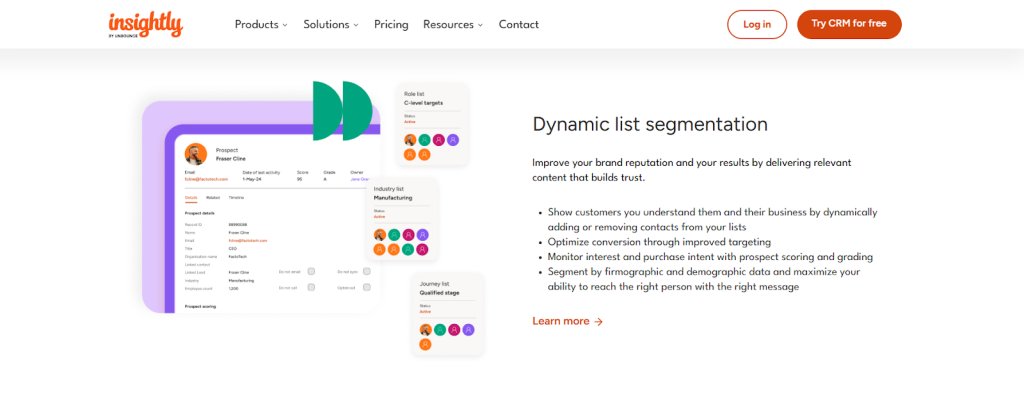
Insightly helps businesses create smarter, more dynamic marketing lists by automatically adding or removing contacts based on real-time firmographic and demographic data. This flexible segmentation ensures that campaigns consistently reach the right audience with relevant messaging, improving brand trust and boosting conversion rates.
By combining dynamic list management with prospect scoring and grading, Insightly also makes it easier to monitor customer interest and purchase intent. This approach helps marketers fine-tune their targeting strategies and maximize the impact of every interaction.
Additional features
Dynamic List Management, Firmographic and Demographic Segmentation, Prospect Scoring and Grading, Conversion Optimization, Audience Targeting, Real-Time Contact Updates, Dashboards
Free trial
- A 14-day trial is available before committing to a plan.
Pricing
- Marketing automation plans offering segmentation features start from $99/account/month, billed annually.
Pros:
- Easy to upload and filter client information for quick navigation and organization.
- Simplifies database management and integrates well with native tools.
Cons:
- Auto-sync and search functionality could be improved, and the CRM features may feel minimal for some users.
- The interface can occasionally be slow, and the lack of a tolerance trigger feature may limit certain use cases.
How can customer segmentation tools drive business growth?

Customer segmentation tools empower businesses to go beyond one-size-fits-all strategies by enabling targeted, data-driven decision-making. Here’s how they contribute to growth across multiple areas:
Enhanced customer understanding
Segmentation tools help identify high-value and loyal customer groups, offering a clearer view of who drives revenue. By grouping customers based on behavior, preferences, or demographics, businesses gain insights into needs and pain points. Many tools also track interactions across channels, providing a complete view of the customer journey.
Targeted marketing and sales
With clearly defined segments, businesses can personalize messages and offers to resonate with specific groups, improving engagement and conversions. Marketing campaigns become more efficient by focusing on the most responsive audiences, while sales teams can tailor their approach based on segment behavior and preferences.
Improved customer experience and loyalty
Segmentation enables personalized shopping experiences, product recommendations, and promotions. This tailored approach increases customer satisfaction and loyalty while helping build stronger, more meaningful relationships—ultimately boosting customer lifetime value.
Smarter product and business decisions
Insights from segmentation reveal unmet needs and trending behaviors, which can guide product development and feature enhancements. Businesses can also allocate resources more effectively by prioritizing efforts toward segments with the highest potential ROI.
Stronger brand reputation
Delivering consistent, personalized experiences across segments helps position a brand as customer-centric and responsive, building trust and enhancing brand perception over time.
FAQs
Segmentation software helps businesses group users based on shared traits or behaviors, enabling more effective targeting, messaging, and personalization.
CRM segmentation involves organizing customer records within a CRM system into defined groups based on attributes or behaviors to support personalized outreach and reporting.
Common types include:
Demographic (e.g., age, gender)
Geographic (e.g., region, city)
Behavioral (e.g., purchase history, engagement)
Psychographics (e.g., interests, values)
Needs-based (e.g., problem being solved)
Value-based (e.g., customer lifetime value)
Technographic (e.g., devices, software, app behavior)
Customer segmentation helps businesses deliver more personalized and relevant experiences, improve marketing efficiency, and focus efforts on high-value groups. It leads to better targeting, increased conversions, and stronger customer relationships.
Market segmentation divides a broad market into groups before acquisition (e.g., by industry or location), while customer segmentation categorizes existing customers based on behavior, preferences, or value to optimize retention, personalization, and growth strategies.
Customer segmentation provides the foundation for journey mapping by grouping users with similar behaviors or needs. This allows businesses to design tailored journeys that reflect each segment’s expectations and stage in the lifecycle.
Yes, many tools offer scalable pricing and simplified features that are ideal for small businesses. These tools help smaller teams focus their marketing and resources on the most promising customer segments.
Widely used marketing automation tools include HubSpot, Mailchimp, Klaviyo, and VWO, popular for their ease of use and robust segmentation features.
The best tool depends on business needs. For example, Segment is great for data-rich personalization, while Mailchimp suits small businesses focused on email segmentation. VWO is an apt choice for companies prioritizing behavioral segmentation, experimentation, and real-time personalization on their websites.
Most modern segmentation tools offer seamless integrations with popular CRM platforms, enabling real-time data sync and unified customer views across systems.
It’s recommended to review and refine segments regularly or whenever major changes occur, such as product launches, market shifts, or noticeable shifts in customer behavior.

